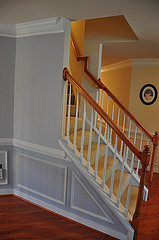Do You Know the Right Way to Care for Natural Woodwork?
 The perfect decorating touch, natural wood accents are very much in style. Kitchen or bathroom cabinetry, wainscoting, chair rails, beadboard paneling, crown molding, and built-in shelving, add character and interest to your home. However, cabinets and trim crafted out of natural wood does require a certain amount of TLC to keep them at their lustrous best. How much do you know about looking after cherry, mahogany, maple, and other beautiful woods? Take this true-false quiz and find out.
The perfect decorating touch, natural wood accents are very much in style. Kitchen or bathroom cabinetry, wainscoting, chair rails, beadboard paneling, crown molding, and built-in shelving, add character and interest to your home. However, cabinets and trim crafted out of natural wood does require a certain amount of TLC to keep them at their lustrous best. How much do you know about looking after cherry, mahogany, maple, and other beautiful woods? Take this true-false quiz and find out.
1. Water is the natural enemy of wood finishes. True or False?
The answer to this is mixed, actually -- while large quantities of water are indeed anathema to wood surfaces, a lightly moistened cloth is the tool of choice when you need to remove stubborn dirt and sticky spills. Just be sure to follow up by drying promptly.
2. Dust is also surprisingly problematic. True or False?
True. Regularly get rid of airborne dust that lands on your woodwork using a soft, non-lint-shedding cloth such as an old undershirt, feather duster, or best, of all, a lamb's wool duster. Otherwise, dust particles may scratch the finish.
3. Wood is at its best in cool, dry conditions. True or False?
False. Cool (not cold) is fine. But too dry an atmosphere may cause sensitive wood to crack. An indoor relative humidity level of 40-45 percent is ideal. Anything above that will be likely to lead to moisture absorption and swelling.
4. Pure olive oil is the best polishing agent for wood. True or False?
False. Polishing with olive oil all on its own will highlight just about every fingerprint, smear, and speck of dust that you might find on the surface of the wood. You can, however, whip up your own safe furniture "soap" by mixing together OO, strained lemon juice, denatured alcohol, and gum turpentine in equal measures. Rub on lightly and use a clean cloth to buff to a shine.
5. Unfinished wood will absorb dirt more readily than finished wood. True or False?
True. Wood has a naturally porous structure and will tend to absorb dirt and grease unless it is finished. This is especially problematic with woodwork that gets a lot of handling and wear, such as banisters or kitchen cabinets. There are various choices of sealer, which include penetrating finishes (wax and linseed, tung or mineral oil) or surface finishes -- shellac, water- or oil-based polyurethane, varnish, lacquer, and paint. If you aren’t sure which is right for you and are desperately thinking, “I need a carpenter near me to help,” Networx can easily put you in touch with a professional.
6. Use of stains and dyes will cover up the natural wood grain. True or False?
False. Stains are used to deepen the color of woodwork while showing off its lovely grain. Dyes add color and an appearance of depth without affecting the grain; they may also be used to disguise scratches in the wood. Sometimes dyes and stains are used in combination to create an attractive hue and accentuate the grain as well.
7. Wood finishes should be allowed to cure after application. True or False?
True. Give your new finish some time to cure after it has been applied to your woodwork. This may be as long as a month; check the product label for specific directions. Take special care during this period to protect against moisture and abrasion. For the best curing result, apply the desired finish coat in dry, mild weather. However, never attempt to finish woods such as aromatic cedar, cocobolo, rosewood, and tulipwood with oil, as they contain antioxidants which would prevent it from curing properly.
Laura Firszt writes for networx.com.
Looking for a Pro? Call us (866) 441-6648

Carpentry Average Costs
Carpenters Experiences

My Deck Repair Was Simple But Perfect

The Stamped Concrete Patio I’ve Been Waiting For



